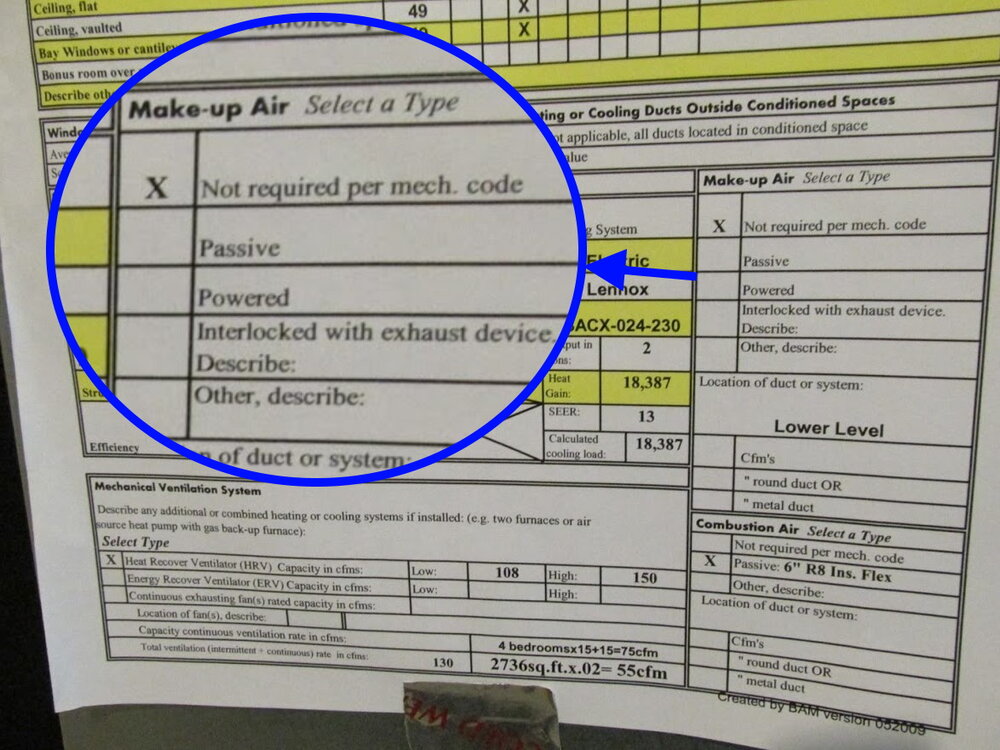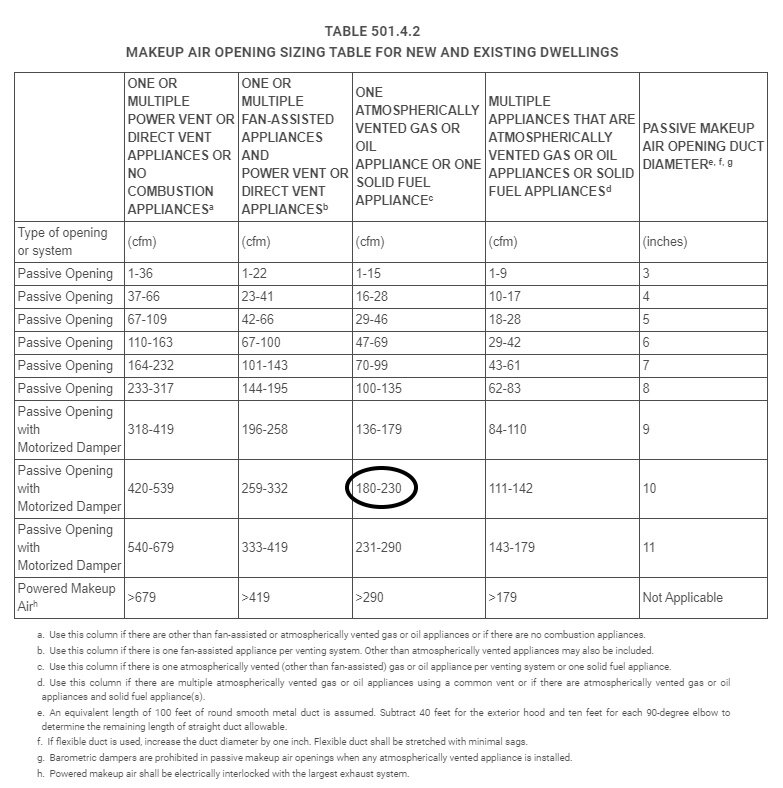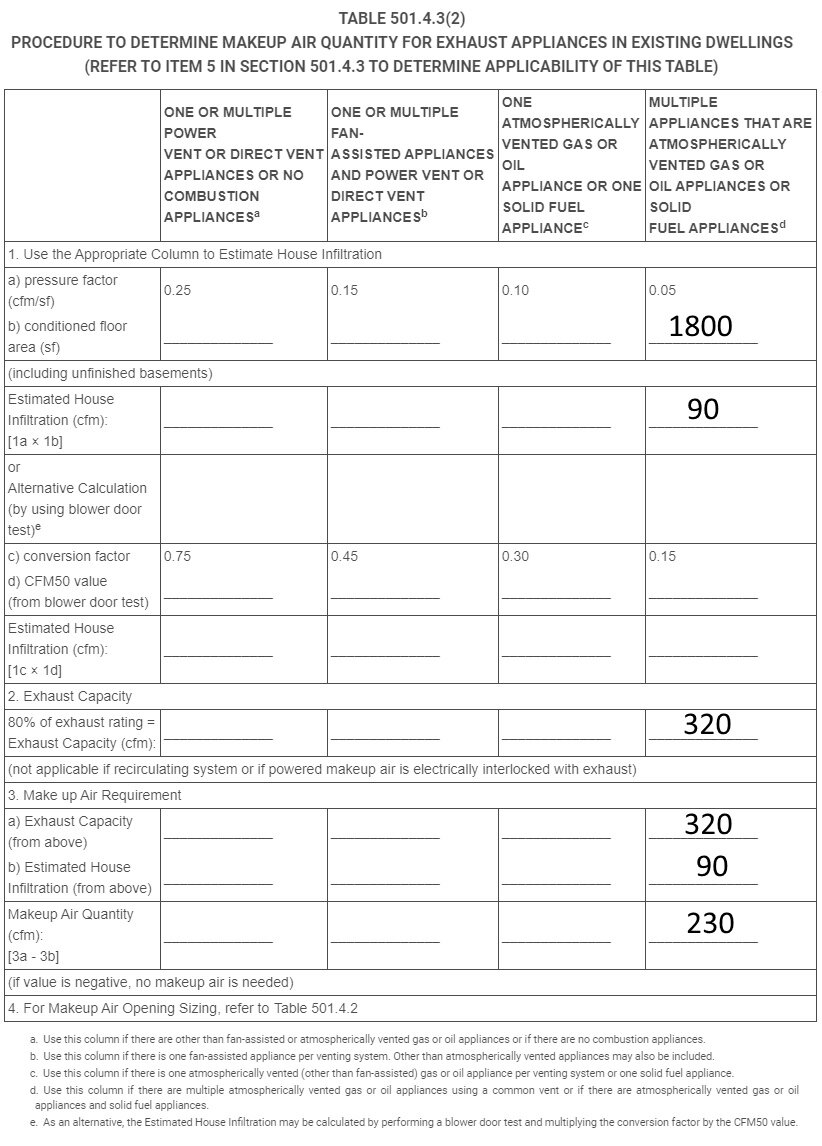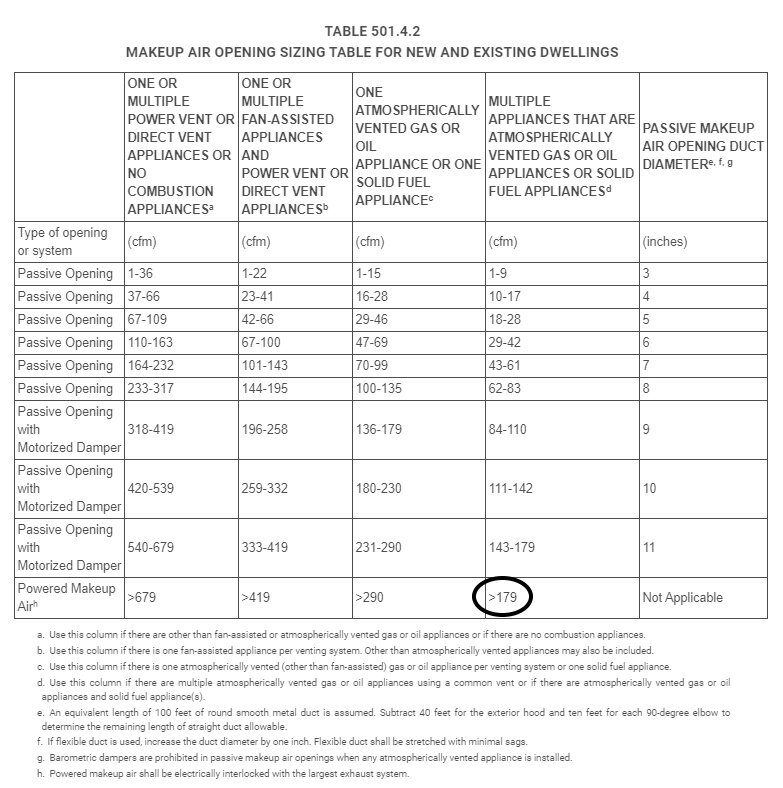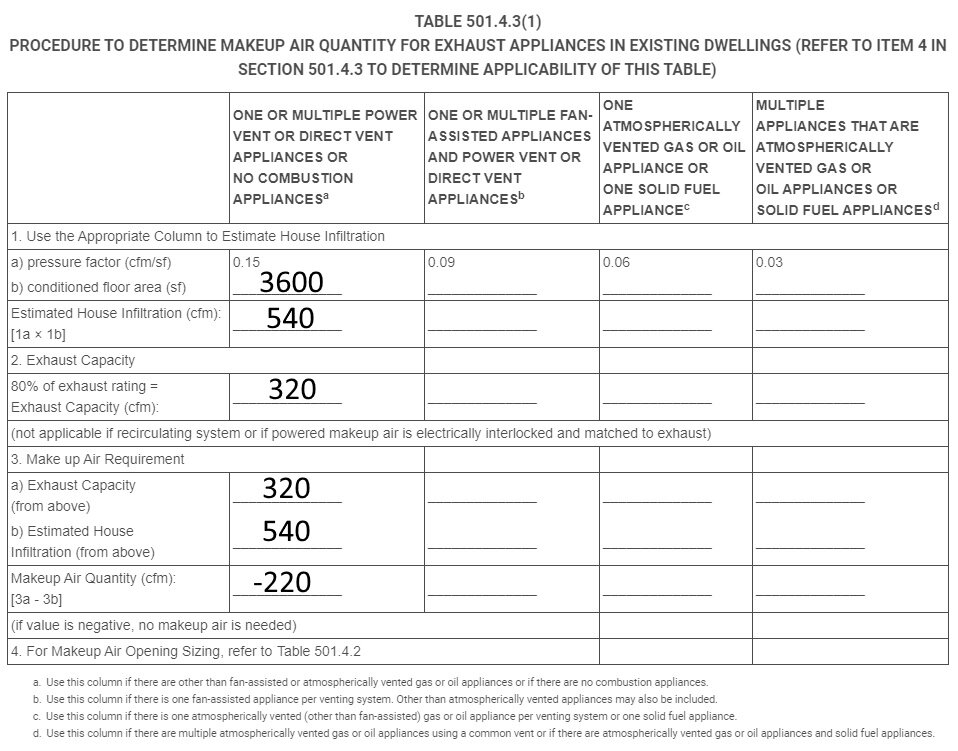Today I’ll explain what makeup air is and when it’s required for a Minnesota home. I’ll also go through a few examples to show how to do your own calculation. I wrote about this back in 2013, but the rules have changed a bit since then, so it’s time for an update. Here’s a video where I tried to break it down and make it simple, but it’s more than 10 minutes long. So much for that.
WHAT IS MAKEUP AIR
Makeup air is needed in homes to replace air that is removed by mechanical devices, such as clothes dryers, kitchen exhaust fans, and bathroom exhaust fans. Makeup air is not the same thing as combustion air. Combustion air is needed to support combustion at appliances such as a furnace or water heater. I discussed some of the calculations for combustion air in this blog post from 2018: Are combustion air ducts needed for large basements?
WHEN MAKEUP AIR IS NEEDED
This is darned complicated, but I’ll do my best to make it easy to follow. For a new construction home, you need to follow section 501.4.1 of the 2020 Minnesota State Mechanical Code (MMC). Those requirements aren’t too tough to follow, and the final determination of the calculation can be found with the building plans.
For existing homes, there’s no single action that will trigger the need for makeup air. When certain changes or alterations to a home’s mechanical system are made, it might trigger the need to do a calculation. The biggest misconception that people have around this is that makeup air is needed anytime a kitchen hood fan over 300-cfm is installed. This does not trigger the need for makeup air. This simply means that someone needs to do some math to figure out if makeup air is needed.
There’s a list of six potential triggers for combustion air, found under section 501.4.3 of the MMC. It’s verbose and confusing, and there are a bunch of exceptions, so here’s my pared-down version to make it easier to understand. Here are the triggers:
-
When installing or replacing a vented combustion appliance or an exhaust system on a home built after 1999. For the most part. Use table 501.4.1 to do the calculation.
-
When installing a solid fuel appliance, such as a wood-burning fireplace.
-
For homes built during or after 1994, use table 501.4.1 for the calculation.
-
For homes built prior to 1994, use table 501.4.3(3) for the calculation.
-
-
When installing an exhaust system with a rated capacity over 300-cfm.
-
For homes built during or after 1994, use table 501.4.3(1) for the calculation.
-
For homes built before 1994, use table 501.4.3(2) for the calculation.
-
In all of these cases, if the calculation determines that combustion air is needed, use table 501.4.2 to figure out how much. And I’ll say it again: my language above is not how the code reads. This is my interpretation. Read the code to get the exact language and to learn about the exceptions.
Besides the specific exceptions for each rule, there are two general exceptions that can be made for combustion air. One is to follow ASTM E1998-02 to prove that combustion air is not needed. I got my hands on a copy of that standard, and it is laughably verbose and complicated. I’d rather install two powered makeup air systems than try to follow that standard. The other exception is when a test is performed that is approved by the building official, proving that the combustion appliances will still function fine without makeup air.
So there you have it. These are the things that trigger the need to do a makeup air calculation. Next, let’s work through a couple of examples. I’ll fill out the forms, and you’ll gain an understanding of how to do this yourself.
SAMPLE CALCULATIONS
Scenario 1: A 1983-built home having a bathroom exhaust fan installed, under 300-cfm. This doesn’t trigger any of the three things I listed above, so no calculation is needed for combustion air.
Scenario 2: A 2006-built home having a gas water heater replaced. This triggers item #1 in my list above, so we’ll use table 501.4.1 for the calculation. For this example, we’ll assume the home has a fan-assisted furnace, a natural draft (atmospherically vented) water heater, and no fireplace. The home is 3600 sf, and it has a 250 cfm kitchen hood fan. It also has three bath fans, each rated at 80 cfm.
Because this home has one atmospherically vented appliance, we need to use column three on this table, which should* give us a pressure factor of .06. I’ll fill in the numbers for that column.
*I found a typo here in the codebook. The number in this column says .6, but it’s supposed to say .06. Please send the the prize directly to my house, thank you.
As you can see, makeup air quantity at the bottom is a positive number, so makeup air is required. We take 183 and bring it over to table 501.4.2, and we use the same column.
This tells us we’ll need a Passive Opening with a Motorized Damper, and the far right column says the duct size must be 10”. Because we’ll likely use an insulated flex duct like everyone else does, footnote f tells us we need to increase the duct diameter by one inch. So we’ll need an 11” duct. For the record, that’s gigantic.
Scenario 3: A 1957-built home is having a 400-cfm kitchen hood fan installed. This triggers #3 in my list above, so we’ll use the calculation for homes built before 1994, Table 501.4.3(2). For this example, we’ll assume the home has a fan-assisted furnace, a natural draft (atmospherically vented) water heater, and a wood-burning (solid-fuel) fireplace. The home is 1800 sf, and it doesn’t have any bathroom exhaust fans.
Because this home has multiple appliances that are atmospherically vented or solid fuel appliances, we have to use the far column on the right for this calculation.
Again, we end up with a positive number, this time it’s 230. We take that over to table 501.4.2, and we use the same column to see what size duct we need.
Because we’re over 179 cfm, this home will need powered makeup air.
Scenario 4: A 1995-built home is having a 400-cfm kitchen hood fan installed. This triggers #3, so we’ll use the calculation for homes built after 1994, Table 501.4.3(1). For this example, we’ll assume the home has a direct vent furnace and a powervent water heater, and two direct-vent gas fireplaces. The home is 3600 sf, and it has four bathroom exhaust fans, each rated at 80 cfm.
Because we have powervent and direct vent appliances, we get to use the first column in the table, which is the most forgiving.
We end up with a negative number in this case, so we don’t need to add any makeup air. We could actually get away with adding a kitchen exhaust fan that’s rated up to 675-cfm, and we still wouldn’t need to add any makeup air.
OUTSIDE OF MINNESOTA
If you’re outside of Minnesota, these rules don’t apply to you. While our rules are complex, I think they’re a great model for other states to follow. The 2018 version of the International Residential Code has a very small, generic, easy-to-follow section on makeup air, found under M1503.6:
Where one or more gas, liquid or solid fuel-burning appliance that is neither direct-vent nor uses a mechanical draft venting system is located within a dwelling unit’s air barrier, each exhaust system capable of exhausting in excess of 400 cubic feet per minute (0.19 m3/s) shall be mechanically or passively provided with makeup air at a rate approximately equal to the exhaust air rate. Such makeup air systems shall be equipped with not fewer than one damper complying with Section M1503.6.2.
To paraphrase: if you have feeble appliances in your home that might backdraft, you need to add makeup air if you install an exhaust system rated at 400-cfm or more. If you add an exhaust system under 400-cfm, nothing is required.
In my humble opinion, this is a joke. The requirements that we have here in Minnesota, while complicated, are light years ahead of this woefully inadequate national formula. This is a great example of why Minnesota amends the national codes to better suit our needs.
CONCLUSION
Homes that required big-time makeup air in the examples above were the homes that rely on gravity to get exhaust gases out of the homes. As I’ve said before many times, these appliances are feeble, and they need lots of extra help to function properly. This is why makeup air is so important.
As for home inspections, doing these types of calculations goes way beyond the scope of what we do. But I think it’s helpful to understand how these are done, and to look over a few examples to fully appreciate why it’s unusual to find gas appliances in new homes that are not direct-vent or power-vent, and why it’s also quite unusual to find new homes with wood-burning fireplaces. And also why you don’t want to go nuts with a huge kitchen hood fan.
Related Links:

